
1
Elimination Diet
PATIENT HANDOUT
University of Wisconsin Integrative Health
www.fammed.wisc.edu/integrative
The Elimination Diet
An elimination diet is an eating plan that omits a food or group of foods believed to cause an adverse
food reaction, often referred to as a “food intolerance.” By removing certain foods for a period of time
and then reintroducing them during a “challenge” period, you can learn which foods are causing
symptoms or making them worse. We often think of reactions to food as being a rapid allergic reaction,
such as when a person has an anaphylactic reaction to eating peanuts and their throat swells up.
However, there are other ways our bodies can react to foods that may not be so immediate, and may or
may not be tied to an immune system response
. Food intolerances may be triggered by various natural
compounds found in foods (natural sugars or proteins) or common food additives (such as natural and
artificial colors, preservatives, antioxidants, and flavor enhancers) that can cause reactions through
various mechanisms in the body. There is currently dispute about the specific mechanisms involved in
different reactions to foods, and many tests to identify the suspected culprit(s) can be unreliable. Clinical
experience has shown that an elimination diet is one of the best tools for identifying food culprits and is
very safe, as long a variety of foods are still eaten supplying all the essential nutrients.
Symptoms
Symptoms of food intolerance can vary widely. They can include stomach and bowel irritation,
headaches, hives, itching, and even vague feelings of being unwell, such as flu-like aches and pains,
unusual tiredness, or concentration problems. Certain foods and food groups are also known to
exacerbate symptoms in people with specific conditions such as autoimmune disorders, migraines,
Irritable Bowel Syndrome, gastroesophageal reflux (GERD) and others.
2
Symptoms and their severity are unique to the individual. They are influenced by specific compounds in
the food, a person’s sensitivity level, and how much of certain foods are eaten. If the same food is eaten
repeatedly, or different foods with the same compound are eaten together or often, the body may reach
a threshold, or a tipping point where symptoms begin to occur.
Natural Food Substances
Even “healthy” foods contain many different naturally occurring chemicals that can be a problem for
some people. Substances common to many different foods, such as salicylates, amines, and glutamate,
may cause symptoms for different individuals. It is beyond the scope of this handout to provide detail
about the different categories of natural substances that may cause symptoms, but this can be explored
with a practitioner who is comfortable working with elimination diets (not all practitioners are).
Individual Variation
Because people are unique genetically, and because we each have different eating patterns, elimination
diets have to be based on each unique individual. Eliminating the most offending food or multiple foods
and substances all at one time is the most reliable way to find out which foods may be contributing to
symptoms. A healthcare practitioner may recommend a specific plan to follow based on symptoms,
typical dietary choices, and food cravings.
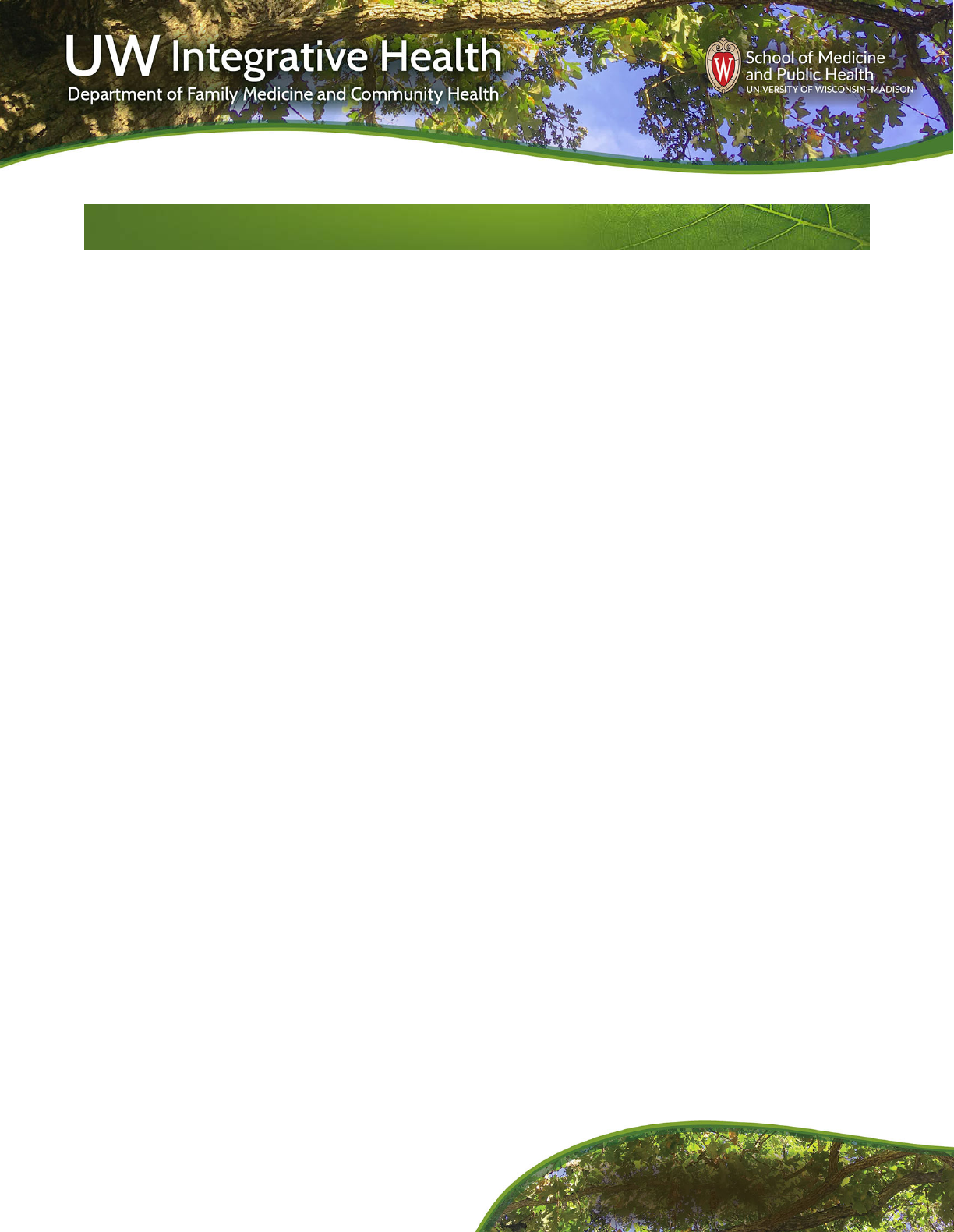
2
Elimination Diet
PATIENT HANDOUT
University of Wisconsin Integrative Health
www.fammed.wisc.edu/integrative
There are four main steps to an elimination diet:
Step 1 – Planning
Work with your health care practitioner to learn which foods might be causing problems. You may be
asked to keep a diet journal for a week, listing the foods you eat and keeping track of the symptoms you
have throughout the day. See the last page of this handout for a Food Diary Chart you can use. It is
helpful to ask yourself a few key questions:
• What foods do I eat most often?
• What foods do I crave?
• What foods do I eat to “feel better”?
• What foods would I have trouble giving up?
Often, these seem to be the foods that are most important to try not to eat. Also, see
Table 1
for a list of
the most common problem foods.
Make a list of potential problem foods.
The elimination diet can vary in intensity depending on how many suspected food culprits are being
avoided. Three different “levels” of food elimination can be followed depending on suspected food culprits
and likelihood of adhering to the diet. The three levels are described below in the
Elimination Diet
Strategies
section on page 6. It is helpful to think about choosing the strategy that is the least restrictive
first in order to maximize successful adherence to the restrictions. However, the more restrictive
strategies are more effective at identifying cases where there are multiple food culprits.
Are You Ready?
Before starting an elimination diet, it is important to consider whether this is a good time to undertake
these potentially large changes in diet. Do you have any upcoming stressful life events or travel? Do you
have the resources, willingness, and energy to create new grocery lists and menus to cook new recipes?
Do you have support from family and friends for eating at home, at work, or out at restaurants and other
events? It will be important to completely eliminate the foods on your list for 2-4 weeks, so if you
accidentally eat one of the foods, you will need to start again. It will be quicker and easier if you are
successful the first time.
Step 2 – Avoiding
Make a list of foods to avoid based on your planning, and be sure of how to avoid possible “hidden foods”
(See Table 3 Hidden Foods).
Begin the elimination diet and for two to four weeks, follow the elimination diet without any exceptions.
Don’t eat the eliminated foods whole or as ingredients in other foods. For example, if you are avoiding all
dairy products, you need to check labels for whey, casein, and lactose so you can avoid them as well. This
The Elimination Diet Steps

3
Elimination Diet
PATIENT HANDOUT
University of Wisconsin Integrative Health
www.fammed.wisc.edu/integrative
step takes a lot of discipline. You must pay close attention to food labels. Be particularly careful if you are
eating out, since you have less control over what goes into the food you eat. If you make a mistake and
eat something on the list, you should start over.
Many people notice that in the first week, especially in the first few days, their symptoms will become
worse before they start to improve. If your symptoms become severe or increase for more than a day or
two, consult your health care practitioner.
Table 1 Common Culprits for Food Allergy and Intolerance
Step 3 – Challenging
• If your symptoms have not improved in two
weeks, continue for up to four weeks. If your
symptoms have not improved by the end of
four weeks, stop the diet and explore whether
or not to try this process again with a different
combination of foods.
• You should be symptom-free for at least 5
days before beginning your food challenges. If your symptoms have improved, start “challenging”
your body with the eliminated foods, one food at a time. As you do this, use the Food Diary at the
end of this document to keep a written record of your symptoms.
• To challenge your body, add a new food back in every three days. It takes three days to be sure that
your symptoms have time to come back if they are going to. It is suggested that you eat a small
amount on day 1 of re-introduction, have about twice the amount on day two, and then an even
larger portion on day 3. See Table 2 for a sample calendar. It is important to note that some foods
Common Food and Food Component Culprits
Foods
Additives and Natural Compounds
Citrus
Antioxidants (butylated hydroxyanisole and hydroxytoluene)
Dairy Products
Aspartame (NutraSweet, an artificial sweetener)
Eggs
Flavor enhancers (monosodium glutamate)
Gluten (barley, oats, rye,
and wheat)
Artificial Food Colors (tartrazine and other Food Dye and Coloring Act [FD&C]
dyes, which are derived from coal tar)
Soy
Lactose and other disaccharides
Peanuts
Nitrate and nitrites (found in preserved meats)
Shellfish
Preservatives (sulfites, benzoates, and sorbates)
Tree Nuts
Thickeners/stabilizers (tragacanth, agar-agar)
Beef products
Biogenic amines (histamine, tyramine, octopamine, and phenylethylamine)
Corn
Salicylates – naturally occurring compounds found in many fruits, vegetables,
some cheeses, herbs, spices, nuts, and medications such as aspirin
Refined sugars (depends on source of sugar)
NOTE: If a food causes you to have an
immediate allergic reaction, such as throat
swelling, a severe rash, or other severe
allergy symptoms, seek medical care and
avoid food challenges unless you are directly
supervised by a physician.

4
Elimination Diet
PATIENT HANDOUT
University of Wisconsin Integrative Health
www.fammed.wisc.edu/integrative
may be tolerated in small amounts, but not larger amounts. Keeping a careful food diary can be very
helpful in identifying these foods.
• It is important to test with the purest form of food available. For example, to test wheat, use a pure
wheat cereal that contains only wheat. You may use a non-dairy milk substitute like rice or other milk
as long as that milk is not on your “avoid” list. Test milk and cheese on separate occasions. Different
cheeses may be differently reactive or not, so best to test on separate occasions. Usually yogurt,
cottage cheese, and butter do not need to be tested separately. For eggs, test the whites and yolks
separately using hard-boiled eggs.
• Food challenges should be done as systematically as possible. Some components of foods, such as
the proteins casein and whey, and the sugar lactose in dairy can be systematically isolated by
careful challenge planning. If you suspect a specific component of a food may be a culprit, try to
work with a knowledgeable healthcare practitioner who can help you develop your plan. However, if
you eliminate an entire food group, it may only be necessary to challenge with one or a few different
foods from that group, not every unique food.
• As soon as a symptom returns, remove the food from the diet, make a note in the food diary and
place that food on the “allergic” list. If you are unsure if you reacted to a food, remove it from your
diet and re-test it in 4-5 days. If a food doesn’t cause symptoms during a challenge, it is unlikely to
be a problem food and can eventually be added back into your diet. However, don’t add the food
back during this challenge period until you have completed the diet and the food challenges. In other
words, go back off that food until you are done with challenges for all the foods you have eliminated.
Step 4 – Creating A New, Long-Term Diet
Based on your results, your health care practitioner can help you plan a way of eating to prevent your
symptoms. Some things to keep in mind:
• This is not a perfect test. It can be confusing to tell for certain if a specific food is the cause. A lot of
other factors (such as a stressful day at work) could interfere with the results. Try to keep things as
constant as possible while you are on the diet.
• Some people have problems with more than one food.
• Be sure that you are getting adequate nutrition during the elimination diet and as you change your
diet for the long-term. For example, if you give up dairy, you must supplement your calcium from
other sources like green leafy vegetables.
• You may need to try several different elimination diets before you identify the problem foods.
• Most people tolerate this diet well, but if you cycle with the diet several times in an effort to narrow in
on the food culprits, your list of allowable foods may become increasingly small. If this happens and
you find that you are becoming increasingly intolerant of, or losing enjoyment of eating, please
consult a healthcare professional.
• You may be able to have some foods you are reactive to on an infrequent or rotational basis. Work
with a knowledgeable healthcare practitioner, if possible, to understand how to plan for this.
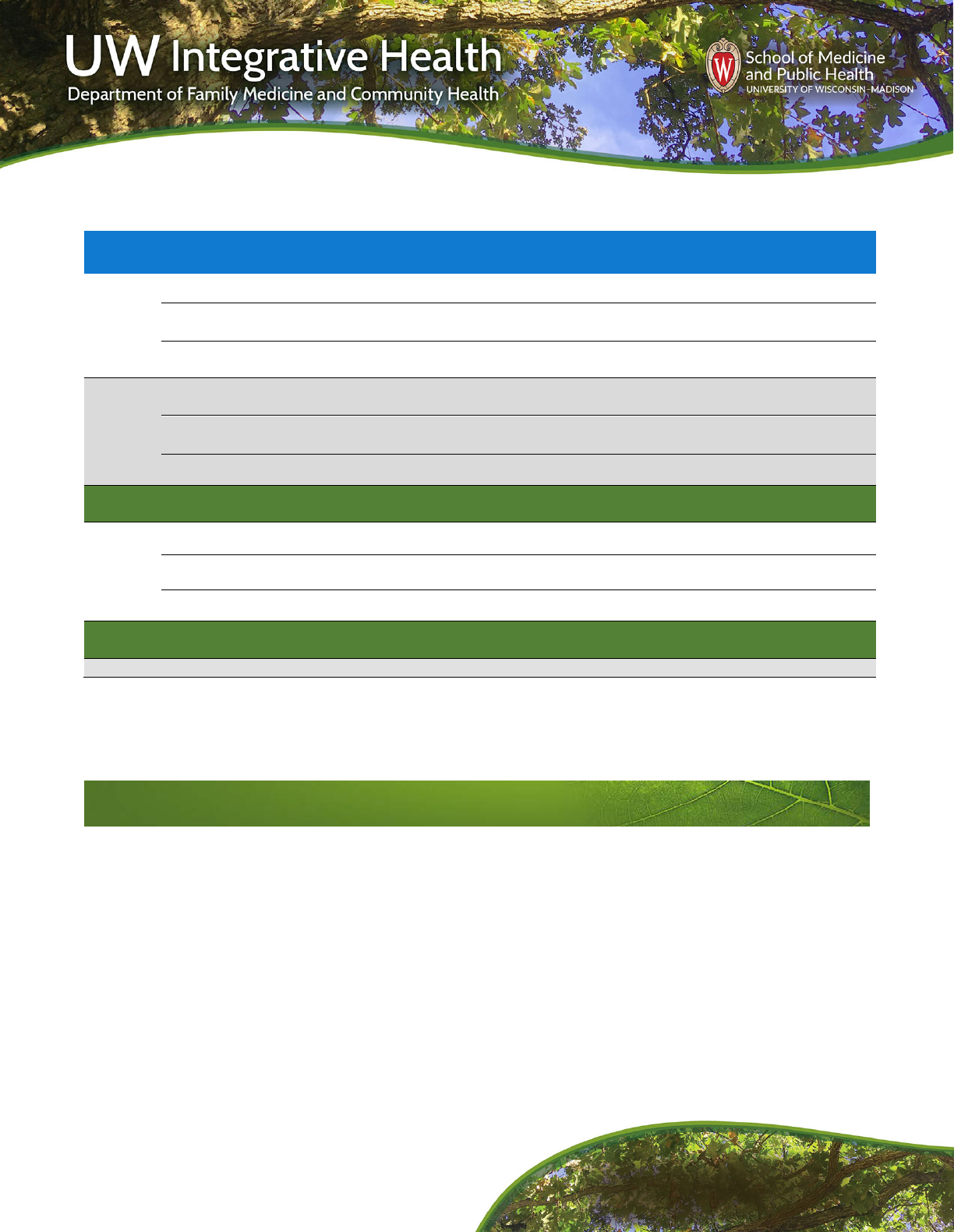
5
Elimination Diet
PATIENT HANDOUT
University of Wisconsin Integrative Health
www.fammed.wisc.edu/integrative
Table 2 Example of an Elimination Diet Calendar*
*IMPORTANT: You only eat a new food for one to three days. Do not add it back into your meal plan again until
the elimination diet is over. If a food causes a symptom, remove it immediately. Wait until your symptom
completely disappears before challenging with the next food.
Level 1: Simple (Modified) Elimination Diet (or dairy and gluten-free)
This is the lowest intensity diet. There are two ways to do this. The specific food, group, or additive
depends on symptoms and suspected culprits.
1. Either just one food, one group of foods, or one food additive is eliminated See Table 1 for the most
common food culprits. This is the easiest diet to follow, but if there are more than one food or groups of
foods that cause symptoms, then this diet may not prove useful. For suspected lactose intolerance,
avoidance of just the dairy food group will be successful. Alternatively, lactase is the enzyme that
digests the disaccharide lactose and can be obtained as an over-the-counter product. If eliminating
lactose make symptoms disappear, dairy may still be enjoyed on occasion with the help of lactase.
2. Alternatively, the 2 most common food group culprits (dairy and wheat) are eliminated. The most
common groups of food proteins that can cause intolerance are cow’s milk protein and glutens from
wheat.
Period
2 Week
Elimination
4 Week
Elimination
Step
Elimination
1 1 Begin Elimination Diet
2-7 2-7 You may notice symptoms worse for a day or two
8-14 8-30 Symptoms should go away if the right foods have been removed
Challenge
#1
15 31 Re-introduce one small portion of food #1 (for example, dairy)
16 32 If no symptoms occur, eat about twice the amount as day 1
17 33 If no symptoms occur, eat about twice the amount as day 2
Remove food #1 from diet again. If it did not cause symptoms, only
add it back to meal plan once elimination diet is over.
Challenge
#2
18 34 Re-introduce one small portion of food #2 (for example, wheat)
19 35 If no symptoms occur, eat about twice the amount as day 1
20 36 If no symptoms occur, eat about twice the amount as day 2
Remove food #2 from diet again. If it did not cause symptoms, only
add it back to meal plan once elimination diet is over.
Continue
21
37
Re-introduce food #3 and continue…
Elimination Diet Strategies
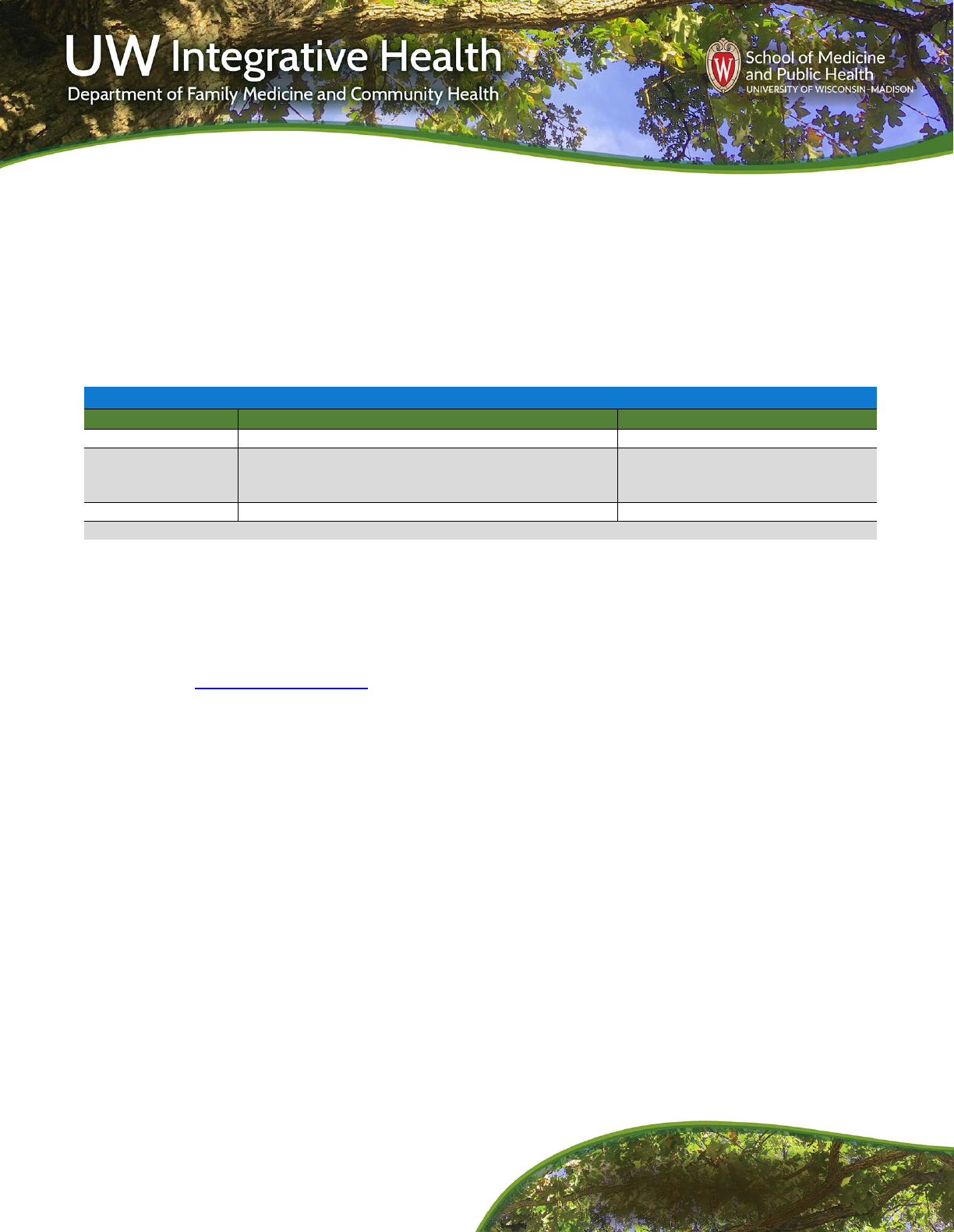
6
Elimination Diet
PATIENT HANDOUT
University of Wisconsin Integrative Health
www.fammed.wisc.edu/integrative
• Eliminate all dairy products, including milk, cream, cheese, cottage cheese, yogurt, butter, ice
cream, and frozen yogurt.
• Eliminate gluten, avoiding any foods that contain wheat, spelt, kamut, oats (certified gluten-free
allowed), rye, barley, or malt. This is the most important part of the diet. Substitute with brown
rice, millet, buckwheat, quinoa, gluten-free flour products, or potatoes, tapioca and arrowroot
products.
Table 3 Simple (or Modified) Elimination Diet
Level 2: Moderate Intensity Elimination Diet
In a moderate intensity elimination diet, several foods or food groups are eliminated all at once. Ideally,
the list of eliminated foods is individually tailored based on symptoms and suspected food culprits. For
example, the low FODMaP diet may be a good choice for symptoms related to Irritable Bowel Syndrome
(IBS) (see the FODMaP Diet handout
).
A knowledgeable healthcare practitioner can help you identify specific food culprits for your condition or
symptoms. Either follow the guidelines detailed below and in
Table 4,
or create a customized list. This
version of the elimination diet may be more successful in eliminating symptoms because it will remove
more suspected culprits all at once.
The suggested moderate intensity elimination diet, in addition to dairy, and wheat, eliminates eggs, all
legumes, nuts, some specific fruits and vegetables, artificial sweeteners, all animal fats, many
vegetables fats, chocolate, coffee, tea, soft drinks, and alcohol. This diet may require a longer challenge
period to identify the food culprits. Pay attention to the fact that it may be expensive to buy the foods
recommended.
• Eliminate all animal protein, but if that is not possible or desirable, fish, poultry, and lamb are
considered to be low allergy. Choose organic/free-range sources where available.
• Avoid alcohol and caffeine and all products that may contain these ingredients (including sodas, cold
preparations, herbal tinctures).
• Avoid foods containing yeast or foods that promote yeast overgrowth, including processed foods,
refined sugars, cheeses, commercially prepared condiments, peanuts, vinegar and alcoholic
beverages.
• Avoid simple sugars such as candy, sweets and processed foods.
• Drink at least 2 quarts of water per day.
Level 1 – Simple (Modified) Elimination Diet– eliminates dairy, and wheat
Food Category
Allowed Foods
Eliminated Foods
Animal proteins
Beef, chicken, lamb, pork, turkey
Dairy products
Grains and
Starches
Arrowroot, barley, buckwheat, corn, millet, oats
(gluten-free), rice, rye, sweet potato, tapioca, white
potatoes, yams
Wheat
Oil
Any non-dairy oils
Dairy-based butter and margarines
All fruits, vegetables, salt, spices, sweeteners, and vegetable proteins are allowed
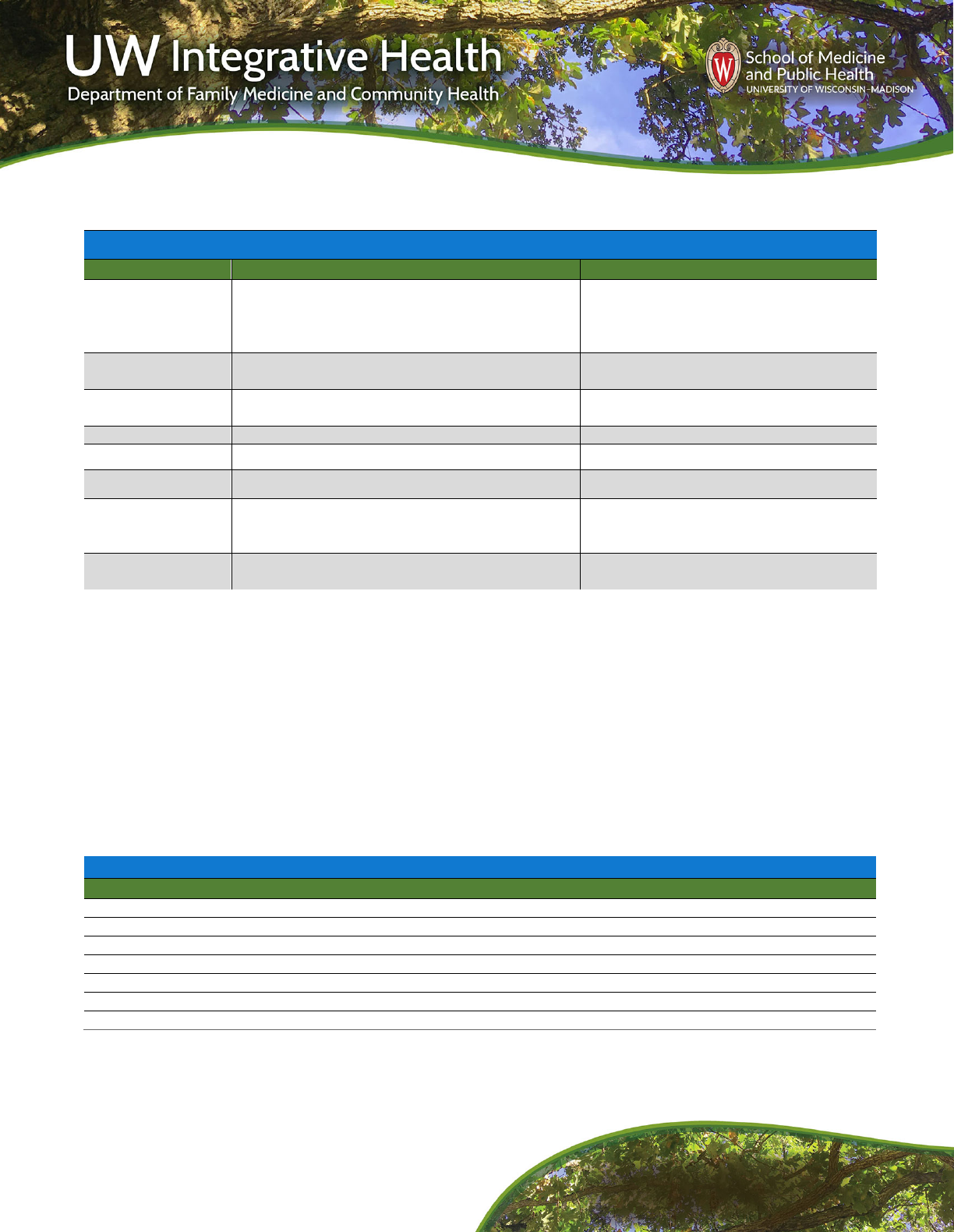
7
Elimination Diet
PATIENT HANDOUT
University of Wisconsin Integrative Health
www.fammed.wisc.edu/integrative
Table 4 Moderate Intensity Elimination Diet
Level 3 The Few-Foods Diet
In this very simplified diet, only a selected list of foods may be eaten. This diet should only be followed for
a limited duration until the food culprits are discovered, to ensure that nutritional deficiencies do not
occur.
•
This diet is the strictest version and only the foods listed in
Table 5
are eaten.
•
Work with your healthcare practitioner, as able, to help you strategize the challenge phase.
•
This is not a long-term diet as it is not nutritionally complete. It is important to add back the foods that
do not cause symptoms once the elimination diet period is over to ensure adequate nutrition.
Table 5 Few Foods Diet
Level 2 – Moderate Intensity Elimination Diet– Eliminates several foods at once
Food Category
Allowed Foods
Eliminated Foods
Animal proteins
Eliminate animal proteins entirely or include
lamb, fish, or poultry (these animal proteins are
considered low-allergenic, but some people can
have sensitivities, so use with caution)
All others, including eggs, milk, cheese,
and all dairy
Vegetable
Proteins
None
Beans, bean sprouts, lentils, peanuts,
peas, soy, all other nuts
Grains and
Starches
Arrowroot, buckwheat, rice, sweet potato,
tapioca, white potato, yams, oats (gluten-free)
Barley, millet, corn, rye, wheat
Vegetables
Most allowed
Peas, tomatoes
Fruits
Most allowed No citrus or strawberries
Sweeteners
Cane or beet sugar, maple syrup Any others, including aspartame
Oils
Coconut, olive, safflower, sesame
Animal fats (lard), butter, corn,
margarine, shortening, soy, peanut,
other vegetable oils
Other
Salt, pepper, a minimal number of spices,
vanilla, lemon extract
Chocolate, coffee, tea, colas and other
soft drinks, alcohol
Level 3 – The Few Foods Diet
Only the foods in the table can be eaten. All others are avoided.
Apples (juice OK)
Cranberries
Pineapple
Apricots
Honey
Rice (including rice cakes and cereal)
Asparagus
Lamb
Safflower oil
Beets
Lettuce
Salt
Cane or beet sugar
Olive Oil
Sweet potatoes
Carrots
Peaches
White vinegar
Chicken
Pears
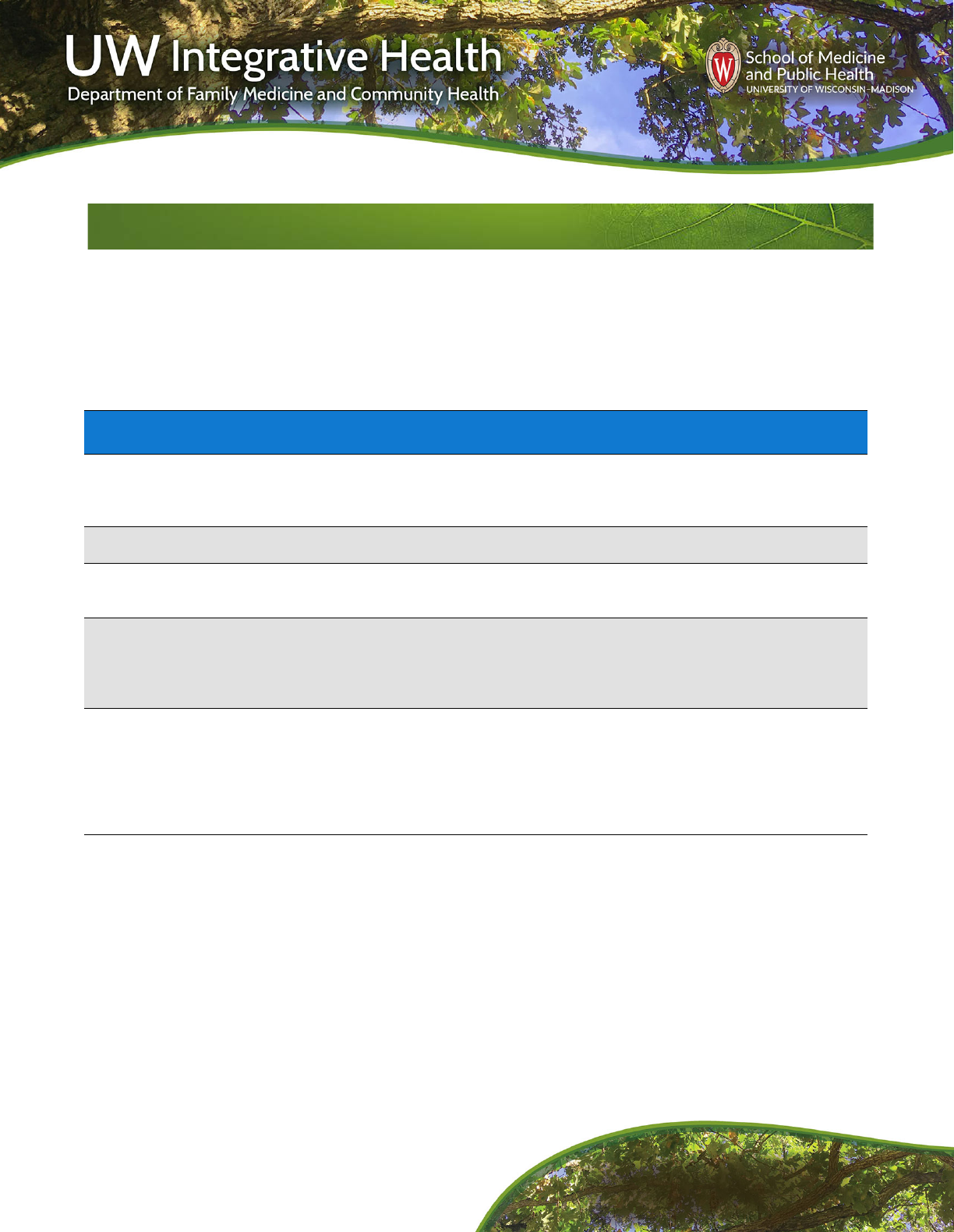
8
Elimination Diet
PATIENT HANDOUT
University of Wisconsin Integrative Health
www.fammed.wisc.edu/integrative
A number of foods can be ‘disguised’ when you look at food labels. See Table 6 below
.
If you are allergic to latex, you may also react to: apple, apricot, avocado, banana, carrot, celery, cherry,
chestnut, coconut, fig, fish, grape, hazelnut, kiwi, mango, melon, nectarine, papaya, passion fruit, peach,
pear, pineapple, plum, potato, rye, shellfish, strawberry, tomato, wheat.
Table 6 Hidden Foods
If you are
avoiding
Also avoid
Dairy
Caramel candy, carob candies, casein and caseinates, custard, curds, lactalbumin, goats milk,
milk chocolate, nougat, protein hydrolysate, semisweet chocolate, yogurt, pudding, whey. Also
beware of brown sugar flavoring, butter flavoring, caramel flavoring, coconut cream flavoring,
“natural flavoring,” Simplesse.
Peanuts
Egg rolls, “high-protein food,” hydrolyzed plant protein, hydrolyzed vegetable protein, marzipan,
nougat, candy, cheesecake crusts, chili, chocolates, pet food, sauces.
Egg
Albumin, apovitellin, avidin, béarnaise sauce, eggnog, egg whites, flavoprotein, globulin,
hollandaise sauce, imitation egg products, livetin, lysozyme, mayonnaise, meringe, ovalbuman,
ovogycoprotin, ovomucin, ovomucoid, ovomuxoid, Simplesse.
Soy
Chee-fan, ketjap, metiauza, miso, natto, soy flour, soy protein concentrates, soy protein shakes,
soy sauce, soybean hydrolysates, soby sprouts, sufu, tao-cho, tao-si, taotjo, tempeh, textured
soy protein, textured vegetable protein, tofu, whey-soy drink. Also beware of hydrolyzed plant
protein, hydrolyzed soy protein, hydrolyzed vegetable protein, natural flavoring, vegetable broth,
vegetable gum, vegetable starch.
Wheat
Atta, bal ahar, bread flour, bulgar, cake flour, cereal extract, couscous, cracked wheat, durum
flour, farina, gluten, graham flour, high-gluten flour, high-protein flour, kamut flour, laubina,
leche alim, malted cereals, minchin, multi-grain products, puffed wheat, red wheat flakes, rolled
wheat, semolina, shredded wheat, soft wheat flour, spelt, superamine, triticale, vital gluten,
vitalia macaroni, wheat protein powder, wheat starch, wheat tempeh, white flour, whole-wheat
berries. Also beware of gelatinized starch, hydrolyzed vegetable protein, modified food starch,
starch, vegetable gum, vegetable starch.
Modified from Mahan LK and Escot-Stump S, Krause’s Food Nutrition and Diet Therapy, 11
th
ed. Philadelphia:
Saunders. 2004.)
The information in this handout is for general education. It is not meant to be used by a
patient alone. Please work with your health care practitioner to use the information in the best
way possible to promote your health.
This handout was written by Sara A. Arscott, PhD, Education and Research Coordinator of the Integrative
Health Program, Dept, of Family Medicine and Community Health adapted and revised from the original
handout created by created by Adam Rindfleisch MPhil., MD, Asst Prof, Medical Director of UW Integrative
Health and David Rakel, MD, former Medical Director of Integrative Health Program, Dept. of Family Medicine,
University of Wisconsin-Madison.
Date revised: Nov 2018
Some Helpful Tips

9
Elimination Diet
PATIENT HANDOUT
University of Wisconsin Integrative Health
www.fammed.wisc.edu/integrative
References
1. Anne Swaine VS, Robert Loblay. RPAH Elimination Diet Handbook with Food & Shopping Guide. In:
Allergy Unit RPAH, ed: Royal Prince Alfred Hospital; 2009.
2. Rakel D. Chapter 86, “The Elimination Diet” Integrative Medicine. 4th ed: Elsevier, Inc.; 2018.
NOTES
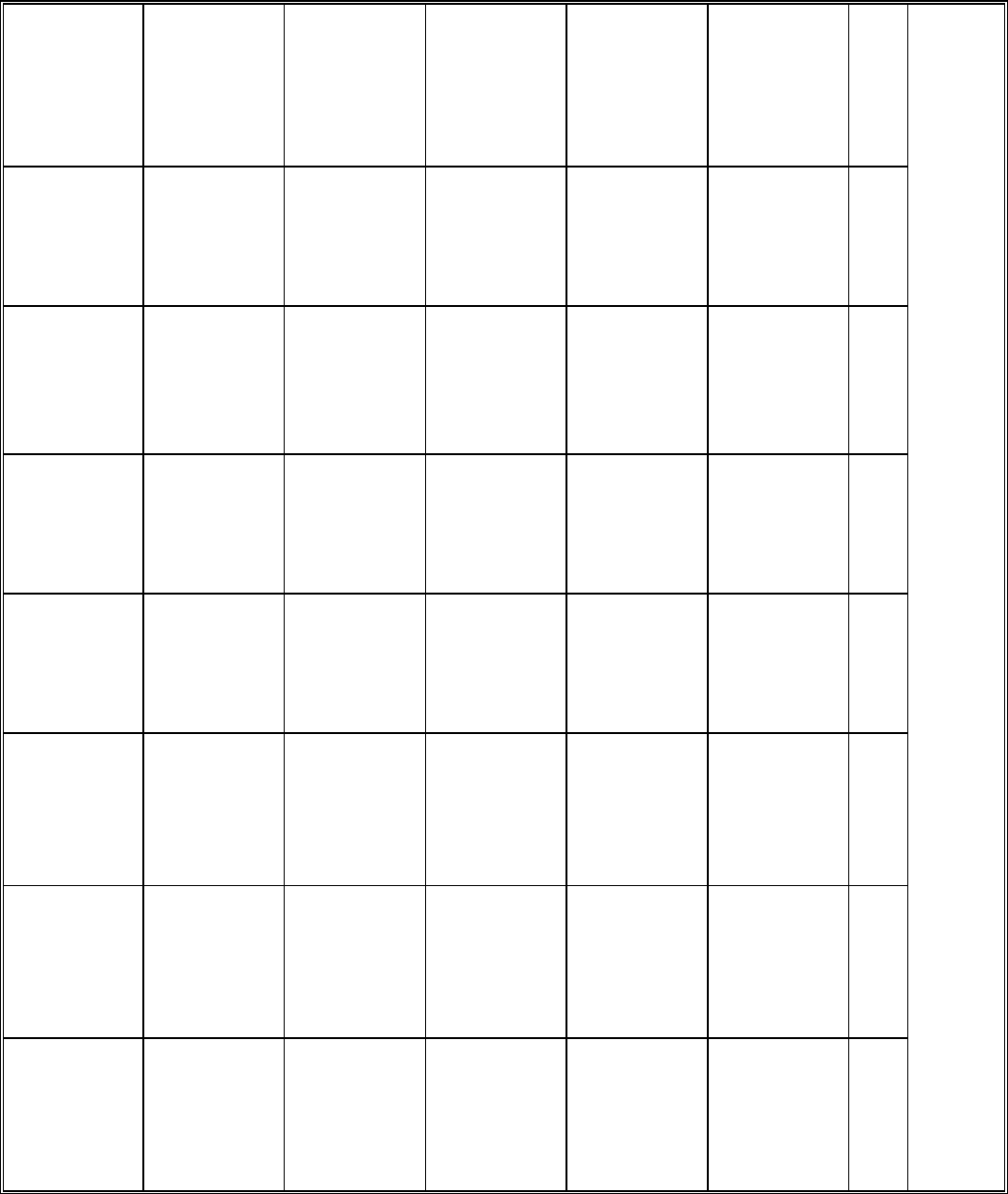
EVENING
SYMPTOMS
EVENING
FOODS
AFTERNOON
SYMPTOMS
AFTERNOON
FOODS
MORNING
SYMPTOMS
MORNING
FOODS
A ONE WEEK FOOD DIARY CHART
(LOG IN ALL FOODS, SUPPLEMENTS, ALCOHOL USE, AND MEDICATIONS TAKEN AND TIMES. NOTE THE
SYMPTOMS YOU HAVE AND WHAT TIMES AS WELL)
DAY 1
DAY 2
DAY 3
DAY 4
DAY 5
DAY 6
DAY 7
